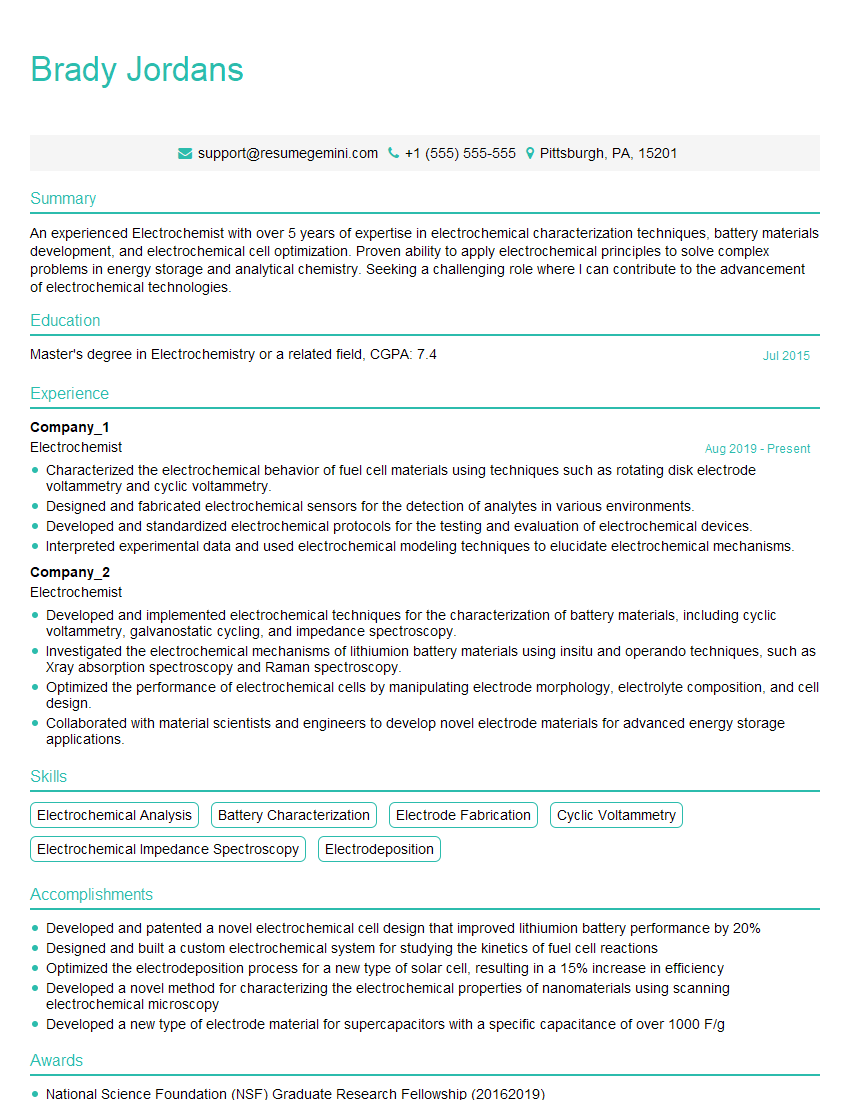The thought of an interview can be nerve-wracking, but the right preparation can make all the difference. Explore this comprehensive guide to Electrochemistry and Spectrophotometry interview questions and gain the confidence you need to showcase your abilities and secure the role.
Questions Asked in Electrochemistry and Spectrophotometry Interview
Q 1. Explain the Nernst equation and its applications.
The Nernst equation is a cornerstone of electrochemistry, predicting the potential of an electrochemical cell under non-standard conditions. It relates the cell potential (E) to the standard cell potential (E°), the temperature (T), the gas constant (R), the number of electrons transferred (n), and the activities (effectively, concentrations) of the reactants and products. The equation is:
E = E° - (RT/nF)lnQwhere Q is the reaction quotient. In simpler terms, it tells us how much the cell voltage deviates from its ideal value (E°) when the concentrations of reactants and products are not at their standard state (1 M for solutions, 1 atm for gases).
Applications: The Nernst equation finds wide use in various fields:
- pH measurement: The glass electrode, a common pH sensor, utilizes the Nernst equation to relate the measured potential to the hydrogen ion concentration (pH).
- Ion-selective electrodes: Similar to pH measurements, these electrodes employ the Nernst equation to determine the concentration of specific ions in a solution.
- Electroplating and corrosion studies: Predicting the potential at which a metal will plate out or corrode relies heavily on the Nernst equation.
- Fuel cell design and optimization: Understanding the voltage output of fuel cells under various operating conditions involves the Nernst equation.
For example, consider a zinc-copper cell. Knowing the standard reduction potentials and the concentrations of Zn2+ and Cu2+, the Nernst equation allows precise prediction of the cell voltage. This is crucial for designing batteries and other electrochemical devices.
Q 2. Describe different types of electrodes used in electrochemistry.
Electrodes are essential components in electrochemical cells, serving as interfaces between the electronic conductor (the electrode itself) and the ionic conductor (the electrolyte). Several types exist, each with specific characteristics:
- Working Electrode: This electrode is where the electrochemical reaction of interest takes place. The material is chosen based on its compatibility with the analyte and the reaction conditions. Common examples include platinum, gold, glassy carbon, and mercury.
- Counter Electrode (Auxiliary Electrode): This electrode completes the electrical circuit and allows current to flow. It is often made of inert materials like platinum to prevent its participation in the main electrochemical reaction. Its primary role is to facilitate charge balance.
- Reference Electrode: This electrode provides a stable and known potential against which the potential of the working electrode is measured. It maintains a constant potential regardless of the current flow in the cell. Common examples include the saturated calomel electrode (SCE) and the silver/silver chloride (Ag/AgCl) electrode.
- Ion-selective electrodes (ISEs): These electrodes are highly selective towards a particular ion. Their potential is directly related to the concentration of the target ion in solution, making them valuable for analytical applications. Examples include electrodes selective for potassium, calcium, and fluoride ions.
The choice of electrode type significantly impacts the outcome and reliability of electrochemical experiments. For instance, using a non-inert working electrode might complicate data interpretation by introducing side reactions.
Q 3. What are the advantages and disadvantages of different electrochemical techniques (e.g., voltammetry, potentiometry)?
Voltammetry and potentiometry are two widely used electrochemical techniques with distinct advantages and disadvantages:
Voltammetry:
- Advantages: Highly sensitive, capable of identifying and quantifying electroactive species, provides information about the kinetics of electrochemical reactions.
- Disadvantages: Can be susceptible to interference from other electroactive species, requires careful control of experimental parameters (scan rate, potential range), may be sensitive to surface effects on the electrode.
Potentiometry:
- Advantages: Relatively simple and inexpensive, non-destructive, can be used for continuous monitoring of analyte concentration.
- Disadvantages: Less sensitive than voltammetry, often requires calibration with standard solutions, may be affected by changes in ionic strength or temperature.
Example: If you need to determine the concentration of a trace metal ion in a complex sample, voltammetry’s high sensitivity might be preferred. However, for continuous monitoring of pH in a process stream, the simplicity and stability of potentiometry are more suitable.
Q 4. Explain the principles of Beer-Lambert Law.
The Beer-Lambert Law describes the attenuation of light as it passes through a solution. It states that the absorbance (A) of a solution is directly proportional to the concentration (c) of the analyte and the path length (l) of the light through the solution. The relationship is expressed as:
A = εlcwhere ε is the molar absorptivity, a constant that represents how strongly the analyte absorbs light at a specific wavelength.
In simpler terms, the darker the solution, the more light is absorbed. This is due to the interaction of light with the analyte molecules, causing some of the light to be absorbed and the rest transmitted. The amount of absorption depends on how many molecules are present (concentration) and how far the light travels through the solution (path length).
Q 5. Describe different types of spectrophotometers and their applications.
Various spectrophotometers are available, each tailored for specific applications:
- UV-Vis Spectrophotometers: These measure absorbance in the ultraviolet and visible regions of the electromagnetic spectrum. They are widely used for quantitative analysis of various compounds, measuring concentrations, identifying unknown substances, and kinetic studies.
- IR Spectrophotometers: These measure absorbance in the infrared region, providing information about the molecular vibrations and functional groups present in a sample. They are invaluable for qualitative analysis of organic compounds and studying molecular structures.
- Atomic Absorption Spectrophotometers (AAS): These analyze the absorbance of light by free atoms in the gaseous phase. They are highly sensitive for determining the concentration of trace metals in various samples like environmental and biological matrices.
- Fluorescence Spectrophotometers: These measure the emitted light when a molecule absorbs light and then re-emits it at a longer wavelength. Applications include studying protein folding, monitoring enzymatic reactions, and detecting biological molecules.
The choice of spectrophotometer depends on the nature of the analyte and the type of information sought. For example, identifying functional groups requires an IR spectrophotometer, while determining the concentration of a metal ion might require an AAS.
Q 6. How do you calibrate a spectrophotometer?
Calibrating a spectrophotometer is crucial for obtaining accurate and reliable results. The process typically involves these steps:
- Blank Calibration: A cuvette containing only the solvent (blank) is placed in the spectrophotometer, and the instrument is set to zero absorbance at each wavelength of interest. This corrects for any absorbance by the solvent or cuvette itself.
- Standard Calibration: Solutions of known concentrations of the analyte are prepared and their absorbance is measured at the appropriate wavelength. A calibration curve (absorbance vs. concentration) is then generated.
- Verification: The calibration is verified using a standard solution whose concentration is independent of the initial set of standards. The absorbance is compared to the expected value from the generated calibration curve to ensure accuracy. This also helps detect any drift or malfunctioning in the instrument.
It’s important to use high-quality cuvettes that are clean and free from scratches, and to ensure that the solution temperature is consistent during the calibration process. Regular calibration, following the manufacturer’s instructions, is essential to maintain the accuracy of the instrument.
Q 7. What are the limitations of Beer-Lambert Law?
Despite its wide applicability, the Beer-Lambert Law has limitations:
- High Concentration Effects: At high concentrations, interactions between analyte molecules can lead to deviations from linearity in the Beer-Lambert plot. The molecules might influence each other’s ability to absorb light, resulting in inaccurate concentration measurements.
- Chemical Deviations: Some analytes undergo chemical changes in solution, affecting their absorption characteristics and causing deviations from linearity. For example, some compounds might form dimers or undergo dissociation.
- Scattering and Fluorescence: The Beer-Lambert law assumes that all light is either absorbed or transmitted. Scattering and fluorescence, where light is re-emitted at a different wavelength, can lead to significant errors in absorbance measurements.
- Stray Light: Stray light reaching the detector outside of the direct light beam can cause deviations from linearity, particularly at high absorbance values.
It’s essential to be aware of these limitations and take appropriate measures (e.g., using dilute solutions, controlling temperature and pH, selecting appropriate wavelengths) to minimize their impact when using the Beer-Lambert law in quantitative analysis.
Q 8. Explain the concept of electrochemical impedance spectroscopy (EIS).
Electrochemical Impedance Spectroscopy (EIS) is a powerful technique used to study the electrochemical properties of materials and interfaces by applying a small amplitude AC signal over a wide range of frequencies. Think of it like gently tapping on a system and listening to how it responds at different speeds. The system’s response – the impedance – is a complex number representing both resistance and capacitance, offering valuable insights into its behavior.
The impedance is measured as a function of frequency, and the resulting data is typically presented as a Nyquist plot (imaginary vs. real impedance) or a Bode plot (magnitude and phase angle vs. frequency). The shape of these plots reveals information about the different processes occurring at the electrode-electrolyte interface, such as charge transfer, diffusion, and adsorption.
For instance, a semicircle in a Nyquist plot often indicates charge-transfer resistance, while a straight line at low frequencies can suggest diffusion-limited processes.
Q 9. How is EIS used to characterize materials?
EIS is used to characterize various material properties, including corrosion resistance, ionic conductivity, and the dielectric properties of materials. For example, in corrosion studies, EIS can reveal the protective quality of a coating on a metal by measuring the impedance of the coated surface. A high impedance indicates a good protective layer because it inhibits the flow of ions and thus corrosion.
In battery research, EIS helps determine the internal resistance of a battery cell, providing insights into its energy efficiency and performance. Similarly, the study of fuel cells benefits from EIS, revealing details on the kinetics of electrochemical reactions within the fuel cell and helping optimize its design.
Analyzing the EIS data involves fitting an equivalent circuit model to the experimental data. These models contain circuit elements (resistors, capacitors, Warburg elements) that represent the different processes contributing to the total impedance. The parameters of the model, such as resistance and capacitance values, give quantitative information about the material’s properties.
Q 10. Describe different types of electrochemical cells.
Electrochemical cells are broadly categorized into several types, based on their function and application. Here are some common examples:
- Galvanic cells (voltaic cells): These cells generate electricity spontaneously from a chemical reaction. A common example is a battery.
- Electrolytic cells: These cells require an external power source to drive a non-spontaneous chemical reaction. Electroplating is a prime example.
- Concentration cells: These cells generate a potential difference due to a difference in concentration of the same electrolyte in two compartments separated by a semipermeable membrane.
- Fuel cells: These cells continuously convert the chemical energy of a fuel (such as hydrogen) and an oxidant (such as oxygen) into electrical energy.
- Photoelectrochemical cells: These cells use light energy to drive electrochemical reactions. Solar cells are a type of photoelectrochemical cell.
The specific type of cell used will depend on the application. For example, if you need a portable power source, a galvanic cell would be suitable, while for a process requiring non-spontaneous chemical reactions like purifying metals, an electrolytic cell would be the appropriate choice.
Q 11. Explain the difference between galvanic and electrolytic cells.
The key difference between galvanic and electrolytic cells lies in the direction of electron flow and the spontaneity of the redox reactions.
In a galvanic cell, the redox reaction occurs spontaneously, producing electrical energy. Electrons flow from the anode (oxidation occurs) to the cathode (reduction occurs) through an external circuit. This is a positive cell potential (E>0). Think of a battery – it spontaneously produces electricity.
In an electrolytic cell, the redox reaction is non-spontaneous and requires an external power source (like a battery or power supply) to drive it. Electrons are forced to flow from the cathode (reduction) to the anode (oxidation). The cell potential is negative (E<0). Think of electroplating – you need an external power source to deposit metal ions onto a surface.
Q 12. What is the role of a reference electrode?
A reference electrode is a crucial component of electrochemical measurements. It provides a stable and known potential against which the potential of the working electrode can be measured. This allows us to accurately determine the potential of the electrochemical reaction occurring at the working electrode.
The reference electrode’s potential must remain constant throughout the experiment, independent of the current flowing through the cell. Common examples include the saturated calomel electrode (SCE) and the silver/silver chloride (Ag/AgCl) electrode. Without a reference electrode, it would be impossible to obtain meaningful electrochemical measurements because the potential of the working electrode would vary randomly making any quantitative analysis impossible.
Q 13. Explain the concept of overpotential.
Overpotential is the extra voltage required beyond the theoretical cell potential to drive an electrochemical reaction at a specific rate. It represents the energy lost due to various factors that hinder the electrochemical reaction at the electrode-electrolyte interface.
Several factors contribute to overpotential, including:
- Activation overpotential: This arises from the energy barrier that reactants must overcome to initiate the electrochemical reaction. Think of it as the activation energy in chemical kinetics.
- Concentration overpotential: This occurs due to depletion of reactants or accumulation of products near the electrode surface, changing the local concentration. This effect is stronger at high current densities.
- Ohmic overpotential: This results from the resistance of the electrolyte and the electrode itself to the flow of current. This is essentially the IR drop across the electrochemical cell.
Overpotential is undesirable as it reduces the efficiency of an electrochemical process. Minimizing overpotential is crucial for optimizing the performance of batteries, fuel cells, and other electrochemical devices.
Q 14. How do you determine the concentration of an analyte using spectrophotometry?
Spectrophotometry uses the principle that the absorbance of light by a solution is directly proportional to the concentration of the analyte. The Beer-Lambert Law mathematically describes this relationship: A = εbc
Where:
Ais the absorbanceεis the molar absorptivity (a constant specific to the analyte and wavelength)bis the path length of the light through the samplecis the concentration of the analyte
To determine the concentration, you first measure the absorbance of the sample using a spectrophotometer at a wavelength where the analyte absorbs strongly. You then need to create a calibration curve by measuring the absorbance of solutions with known concentrations of the analyte. Plotting absorbance (A) versus concentration (c) gives a straight line, whose slope equals εb. By using this calibration curve and the absorbance of the unknown sample, one can easily determine its concentration using the equation of the calibration curve.
For example, if you are analyzing a solution of copper ions, you would measure the absorbance at a wavelength around 600nm, where copper ions have a strong absorbance. By using the Beer-Lambert law and a calibration curve, you could accurately determine the copper concentration in your sample.
Q 15. What are the different types of spectroscopy used in analytical chemistry?
Spectroscopy is a powerful analytical technique that studies the interaction of electromagnetic radiation with matter. Different types of spectroscopy utilize different regions of the electromagnetic spectrum, providing unique information about the sample’s composition and structure. Common types used in analytical chemistry include:
- UV-Vis Spectroscopy: Uses ultraviolet and visible light to analyze electronic transitions in molecules.
- Infrared (IR) Spectroscopy: Employs infrared radiation to study vibrational modes of molecules.
- Atomic Absorption Spectroscopy (AAS): Measures the absorption of light by free atoms in the gaseous phase.
- Nuclear Magnetic Resonance (NMR) Spectroscopy: Uses radio waves to study the magnetic properties of atomic nuclei.
- Mass Spectrometry (MS): Measures the mass-to-charge ratio of ions to determine the sample’s composition.
- Raman Spectroscopy: Exploits inelastic scattering of light to provide vibrational information, complementary to IR.
The choice of spectroscopy depends on the specific information needed and the nature of the sample. For example, UV-Vis is excellent for identifying conjugated systems in organic molecules, while IR is better for identifying functional groups. AAS is ideal for determining the concentration of metal ions.
Career Expert Tips:
- Ace those interviews! Prepare effectively by reviewing the Top 50 Most Common Interview Questions on ResumeGemini.
- Navigate your job search with confidence! Explore a wide range of Career Tips on ResumeGemini. Learn about common challenges and recommendations to overcome them.
- Craft the perfect resume! Master the Art of Resume Writing with ResumeGemini’s guide. Showcase your unique qualifications and achievements effectively.
- Don’t miss out on holiday savings! Build your dream resume with ResumeGemini’s ATS optimized templates.
Q 16. Explain the principles of UV-Vis spectroscopy.
UV-Vis spectroscopy is based on the principle that molecules absorb ultraviolet and visible light at specific wavelengths, causing electronic transitions within the molecule. The amount of light absorbed is directly proportional to the concentration of the analyte, following the Beer-Lambert Law: A = εbc, where A is absorbance, ε is the molar absorptivity, b is the path length, and c is the concentration.
In a UV-Vis spectrophotometer, a beam of light is passed through a sample, and the amount of light transmitted is measured. The absorbance is then calculated, and using a calibration curve (a plot of absorbance versus concentration of known standards), the concentration of the analyte in an unknown sample can be determined. For example, we can use UV-Vis to quantify the concentration of a dye in a solution by measuring its absorbance at its characteristic wavelength.
The technique is widely used in various fields, such as environmental monitoring (measuring pollutants), pharmaceutical analysis (determining drug purity), and clinical chemistry (analyzing blood samples).
Q 17. Explain the principles of IR spectroscopy.
IR spectroscopy is based on the principle that molecules absorb infrared radiation at frequencies corresponding to their vibrational modes. Different functional groups exhibit characteristic absorption bands in specific regions of the IR spectrum. The spectrum provides a ‘fingerprint’ of the molecule, aiding in its identification and structural elucidation.
The instrument passes infrared light through a sample, and the detector measures the amount of light transmitted at each frequency. Absorption bands appear as dips in the transmittance spectrum. For instance, a strong absorption band around 1700 cm-1 suggests the presence of a carbonyl (C=O) group, while a broad band around 3300 cm-1 indicates an O-H or N-H bond. Think of it like a molecular ‘vibration signature’; each molecule vibrates uniquely, revealing its identity through its IR spectrum.
Applications are widespread, including quality control in polymer production, identifying organic compounds in forensics, and studying chemical reactions in real-time.
Q 18. Explain the principles of atomic absorption spectroscopy (AAS).
Atomic absorption spectroscopy (AAS) is a quantitative technique used to measure the concentration of specific elements in a sample. It’s based on the principle that atoms in the gaseous phase absorb light at specific wavelengths characteristic of that element. The amount of light absorbed is directly proportional to the concentration of the element in the sample.
In AAS, a sample is atomized (converted into free atoms) using a flame or graphite furnace. A hollow cathode lamp, emitting light at the specific wavelength for the target element, illuminates the atomized sample. The amount of light absorbed is measured, and the concentration is determined using a calibration curve. This method is highly sensitive and specific, making it useful for detecting trace metals in various materials.
For example, AAS is commonly employed in environmental analysis for measuring heavy metal contamination in water and soil, and in food safety for detecting trace elements in food products.
Q 19. How do you troubleshoot a malfunctioning spectrophotometer?
Troubleshooting a malfunctioning spectrophotometer requires a systematic approach. First, ensure the instrument is properly powered and connected. Check the lamp, making sure it’s correctly aligned and not burnt out. Clean the cuvettes thoroughly; fingerprints or scratches can significantly affect readings. Verify the wavelength accuracy by using a standard with a known absorbance at a specific wavelength. If the baseline isn’t correct, adjust it using the instrument’s controls.
If the problem persists, inspect the instrument’s internal components for any visible damage. Consult the instrument’s manual for detailed troubleshooting steps, and if necessary, contact technical support or a qualified service technician. Always document the troubleshooting process and the solutions implemented.
Regular preventative maintenance, such as cleaning and calibration, is crucial for preventing malfunctions and ensuring the instrument’s accuracy and longevity.
Q 20. How do you prepare samples for electrochemical and spectrophotometric analysis?
Sample preparation is critical for accurate and reliable results in both electrochemical and spectrophotometric analyses. The preparation method depends on the sample’s nature and the specific analytical technique. For example, solid samples often require dissolution in a suitable solvent, while liquid samples may need dilution or filtration to remove particulate matter.
Spectrophotometry: Samples should be dissolved in a solvent that doesn’t absorb light at the wavelengths of interest. The concentration should be within the linear range of the Beer-Lambert law. Cuvettes must be clean and free from scratches. For example, in analyzing a colored solution, the solvent must be transparent at the absorption wavelength of the colored compound.
Electrochemistry: Samples often require preparation to achieve a homogeneous solution with appropriate conductivity and pH. Electrolyte solutions need careful preparation to maintain ionic strength and pH, impacting electrode behavior. Solid samples might need electrode polishing and surface cleaning to ensure proper contact.
Accurate sample preparation is paramount to obtaining valid and reliable experimental results; errors here can propagate throughout the analysis.
Q 21. Describe different methods for data analysis in electrochemistry and spectrophotometry.
Data analysis in electrochemistry and spectrophotometry involves various methods to extract meaningful information from the obtained data. In spectrophotometry, the Beer-Lambert Law is the fundamental basis for quantitative analysis. A calibration curve, plotting absorbance versus concentration of known standards, allows for the determination of unknown concentrations. Software packages are frequently used for curve fitting and data analysis.
In electrochemistry, common techniques include:
- Cyclic Voltammetry: Analyzing current-voltage curves to determine redox potentials and electron transfer kinetics.
- Chronoamperometry: Measuring current as a function of time to study diffusion-controlled processes.
- Potentiometry: Measuring potential differences to determine concentrations or activities of ions.
Data analysis involves fitting the data to appropriate models and using statistical methods to evaluate the results. Software packages for electrochemical analysis help visualize and interpret the data, often providing parameters like diffusion coefficients or rate constants. Proper error analysis is essential to provide reliable and accurate results.
Q 22. Explain the concept of Faraday’s laws of electrolysis.
Faraday’s laws of electrolysis describe the quantitative relationship between the amount of electricity passed through an electrolyte solution and the amount of substance deposited or liberated at the electrodes. Imagine it like this: you’re depositing a layer of metal onto something using electricity – Faraday’s laws tell you exactly how much metal you’ll get based on how much electricity you use.
First Law: The mass of a substance deposited or liberated at an electrode is directly proportional to the quantity of electricity passed through the electrolyte. This means double the electricity, double the metal deposited. Mathematically, this is represented as:
m = ZQ, where ‘m’ is the mass, ‘Z’ is the electrochemical equivalent (a constant for a given substance), and ‘Q’ is the quantity of electricity (in Coulombs).Second Law: When the same quantity of electricity is passed through different electrolytes, the masses of the substances deposited or liberated are proportional to their equivalent weights. This means if you use the same amount of electricity on solutions of different metals, the ratio of the deposited masses will reflect the ratio of their equivalent weights (atomic weight divided by valence).
These laws are fundamental to electroplating, electrorefining, and other electrochemical processes. For instance, understanding Faraday’s laws is crucial for determining the amount of current and time needed to deposit a specific thickness of gold onto a jewelry piece.
Q 23. What are the safety precautions to consider when working with electrochemical and spectrophotometric instruments?
Safety is paramount when working with electrochemical and spectrophotometric instruments. Electrochemical setups often involve corrosive chemicals and high voltages, while spectrophotometers utilize intense light sources. Here’s a breakdown of key precautions:
Electrochemical Instruments: Always wear appropriate personal protective equipment (PPE), including gloves, eye protection, and lab coats. Work in a well-ventilated area to mitigate exposure to hazardous fumes. Ensure proper grounding to prevent electrical shocks. Never touch exposed wires or electrodes while the instrument is powered on. Follow established procedures for handling and disposing of chemicals.
Spectrophotometric Instruments: Never look directly into the light source of a spectrophotometer. These can emit intense UV or visible light, causing eye damage. Always use the appropriate cuvettes designed for the instrument and wavelength range to avoid breakage and potential injury. Clean up spills immediately and properly dispose of solvents and solutions.
General Laboratory Safety: Maintain a clean and organized workspace. Follow all safety protocols specific to your institution and the chemicals being used. Be aware of emergency procedures and locations of safety equipment, such as eyewash stations and fire extinguishers.
Regular maintenance and calibration of instruments are also essential for safe and accurate operation.
Q 24. How do you validate analytical methods?
Method validation ensures an analytical method is fit for its intended purpose, confirming its accuracy, precision, and reliability. This involves a series of tests demonstrating its performance characteristics. Think of it as a rigorous quality check for your analytical procedures.
Specificity/Selectivity: Demonstrates that the method measures only the analyte of interest and is not affected by other components in the sample.
Linearity: Shows a linear relationship between the analyte concentration and the measured signal over a specific range.
Accuracy: Evaluates the closeness of the measured value to the true value. Often assessed using certified reference materials.
Precision: Measures the reproducibility of the method. Expressed as repeatability (within-run) and intermediate precision (between-run or between-days).
Limit of Detection (LOD) and Limit of Quantification (LOQ): Determine the lowest concentration of the analyte that can be reliably detected and quantified, respectively.
Robustness: Assesses the method’s resistance to small variations in experimental conditions, like temperature or reagent concentration.
Validation reports should be meticulously documented, including the procedures used, results, and conclusions drawn. This ensures traceability and supports the credibility of the analytical data generated.
Q 25. Describe your experience with specific electrochemical or spectrophotometric techniques.
My experience encompasses both electrochemical and spectrophotometric techniques. In my previous role, I extensively used cyclic voltammetry (CV) to study the electrochemical behavior of novel organic molecules. CV allows for the investigation of redox processes, determining parameters such as the formal potential, peak current, and electron transfer kinetics. I analyzed the obtained voltammograms using specialized software to extract meaningful data. Additionally, I have significant experience with UV-Vis spectrophotometry for quantitative analysis of various compounds, including determining concentrations using Beer-Lambert’s law and performing kinetic studies monitoring absorbance changes over time.
For example, in one project, I used CV to characterize the electrocatalytic activity of a modified electrode for oxygen reduction reaction (ORR), a key process in fuel cells. In another project, I employed UV-Vis spectroscopy to monitor the degradation kinetics of a specific dye in wastewater treatment processes. I’m proficient in operating and maintaining several instruments such as Autolab potentiostat/galvanostat and various UV-Vis spectrometers.
Q 26. Explain how you would approach troubleshooting a problem in an electrochemical experiment.
Troubleshooting electrochemical experiments often involves a systematic approach. Let’s say you’re getting unexpected results in a voltammetric experiment. Here’s how I would tackle it:
Inspect the Setup: Begin by visually inspecting the entire setup. Look for any loose connections, damaged electrodes, or air bubbles in the cell.
Verify the Electrolyte and Reference Electrode: Confirm the electrolyte’s concentration, purity, and potential contamination. Ensure the reference electrode is properly functioning and the junction is free of clogs. A faulty reference electrode can severely impact your results.
Check the Instrumentation: Verify the instrument’s settings (scan rate, potential window, etc.) are correct and consistent with the experimental design. Calibrate the instrument if necessary.
Test with a Known System: To rule out issues with the instrument itself, perform an experiment with a known system exhibiting well-established electrochemical behavior. This helps isolate problems related to the instrument versus your experimental setup.
Examine the Data: Analyze the obtained data carefully. Unanticipated peaks or unusually high background current may indicate interfering species or experimental flaws.
Systematic Variation of Parameters: If the problem persists, systematically vary experimental parameters, such as scan rate, electrolyte concentration, or electrode material to pinpoint the source of the error.
Maintaining a detailed laboratory notebook is crucial for tracking experiments, parameters, and potential troubleshooting steps.
Q 27. How do you ensure accuracy and precision in your measurements?
Accuracy and precision are crucial for reliable results. Several strategies are employed to ensure this:
Instrument Calibration: Regular calibration of instruments using certified reference materials is essential for accuracy. This ensures the instrument readings are traceable to known standards.
Proper Sample Preparation: Careful sample preparation and handling are critical for minimizing error. This includes using appropriate solvents, avoiding contamination, and employing accurate weighing and dilution techniques.
Replicate Measurements: Performing multiple replicate measurements allows for the assessment of precision, revealing variability in the data and providing statistically robust results. The average of replicate measurements provides a more reliable estimate of the true value.
Appropriate Statistical Analysis: Statistical methods should be used to analyze the data, assess uncertainty, and evaluate significant differences between samples or groups. This may include t-tests, ANOVA, or other relevant statistical tests.
Quality Control Samples: Regular analysis of quality control samples (with known concentrations) interspersed with the experimental samples helps monitor the performance of the method and identify potential systematic errors or drifts over time.
By employing these strategies, one can obtain accurate and precise results, ensuring the reliability of the research findings and conclusions drawn.
Q 28. Describe a time you had to solve a complex analytical problem.
In a previous project, we were tasked with analyzing the trace amounts of a specific heavy metal in environmental samples using an existing method which was giving inconsistent and unreliable results. The existing method lacked sensitivity and precision for these low concentrations. We had to improve the method’s performance to meet regulatory requirements. The challenge was that the interfering substances in the environmental samples were masking the signal of the heavy metal we aimed to measure.
To solve this, I first reviewed the existing literature and explored various sample preparation and analytical techniques, considering extraction methods, different detection methods and pre-concentration techniques. Ultimately, we developed a new sample preparation procedure using solid phase extraction (SPE) to efficiently remove the interfering substances. This coupled with an optimized and highly sensitive detection technique (Inductively Coupled Plasma Mass Spectrometry – ICP-MS) provided accurate and precise results for trace-level quantification. This improved method successfully met the regulatory requirements and enhanced the reliability of our analysis.
Key Topics to Learn for Electrochemistry and Spectrophotometry Interview
- Electrochemistry Fundamentals: Nernst equation, electrochemical cells (galvanic and electrolytic), electrode potentials, types of electrodes, polarography, voltammetry.
- Electrochemical Techniques: Potentiometry, coulometry, amperometry, and their applications in various fields like environmental monitoring, biochemical analysis, and material science.
- Spectrophotometry Principles: Beer-Lambert Law, types of spectrophotometry (UV-Vis, IR, Atomic Absorption), instrument components and their function.
- Practical Applications of Spectrophotometry: Quantitative and qualitative analysis, kinetics studies, determination of analyte concentrations in various samples (e.g., environmental, pharmaceutical, biological).
- Data Analysis and Interpretation: Understanding calibration curves, error analysis, data representation and interpretation for both electrochemical and spectrophotometric techniques.
- Problem-Solving Approaches: Develop a systematic approach to troubleshoot experimental issues, analyze data, and interpret results in the context of both Electrochemistry and Spectrophotometry.
- Advanced Topics (Consider based on job description): Electrochemical impedance spectroscopy, surface plasmon resonance, Raman spectroscopy, fluorescence spectroscopy.
Next Steps
Mastering Electrochemistry and Spectrophotometry opens doors to exciting careers in diverse fields like analytical chemistry, materials science, biotechnology, and environmental science. A strong understanding of these techniques significantly enhances your employability and opens opportunities for career advancement. To maximize your job prospects, focus on building an ATS-friendly resume that highlights your skills and experience effectively. ResumeGemini is a trusted resource that can help you create a professional and impactful resume. We offer examples of resumes tailored to Electrochemistry and Spectrophotometry to guide you in showcasing your qualifications effectively. Take the next step in your career journey – craft a compelling resume that reflects your expertise and secures your dream job.
Explore more articles
Users Rating of Our Blogs
Share Your Experience
We value your feedback! Please rate our content and share your thoughts (optional).
What Readers Say About Our Blog
Interesting Article, I liked the depth of knowledge you’ve shared.
Helpful, thanks for sharing.
Hi, I represent a social media marketing agency and liked your blog
Hi, I represent an SEO company that specialises in getting you AI citations and higher rankings on Google. I’d like to offer you a 100% free SEO audit for your website. Would you be interested?











